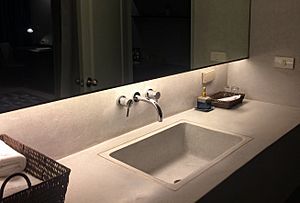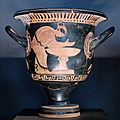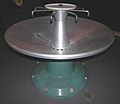Sink facts for kids


A sink (also known as a wash basin or hand basin) is a special bowl that helps us wash things. It's a common part of the plumbing system in homes and buildings. Sinks help us clean our hands, wash dishes, or prepare food. They usually have two taps (also called faucets) that give us hot and cold water. Sinks also have a drain to let the used water flow away. Some sinks even have a soap dispenser built in, which makes washing even easier.
Contents
How Sinks Work
Sinks are connected to a building's water supply and drainage system. When you turn on the taps, water flows into the basin. The hot water usually comes from a water heater, while the cold water comes directly from the main supply.
Water Flow and Drainage
The water fills the sink bowl. When you are done, you can pull a plug or open a stopper in the drain. This allows the water to go down the drainpipe. The drainpipe carries the used water away from the sink and into the building's main drainage system. From there, it goes to a sewer or a septic tank for treatment.
Sink Features
Many sinks have extra features to make them more useful.
- Taps: These control the flow and temperature of the water. Some sinks have separate taps for hot and cold water, while others have a single mixer tap.
- Drains: The opening at the bottom of the sink where water exits. It often has a stopper or plug to hold water in the basin when needed.
- Overflow: Some sinks have a small hole near the top of the basin. This is an overflow hole. It helps prevent the sink from overflowing if you accidentally leave the tap running while the plug is in.
- Soap Dispensers: Many modern sinks, especially in kitchens, have built-in dispensers for liquid soap.
Types of Sinks
Sinks come in many shapes, sizes, and materials. They are designed for different uses in different parts of a building.
Kitchen Sinks
Kitchen sinks are usually larger and deeper than bathroom sinks. They are made to handle washing dishes, pots, and pans. Many kitchen sinks have two bowls: one for washing and one for rinsing. They are often made from stainless steel, porcelain, or granite.
Bathroom Sinks
Bathroom sinks, also called wash basins, are typically smaller. They are mainly used for washing hands, brushing teeth, and grooming. They can be made from ceramic, glass, or even stone. There are different styles, like pedestal sinks that stand on a column, or vessel sinks that sit on top of a counter.
Utility Sinks
Utility sinks are found in laundry rooms, garages, or workshops. They are very deep and durable, made for tough jobs like washing dirty clothes, cleaning tools, or even washing pets. These sinks are often made from strong materials like plastic or concrete.
Materials Used for Sinks
Sinks are made from a variety of materials, each with its own benefits.
- Stainless Steel: Very popular for kitchen sinks because it's durable, easy to clean, and resists stains.
- Ceramic/Porcelain: Common for bathroom sinks. It's smooth, easy to clean, and comes in many colors.
- Cast Iron: Often coated with enamel, these sinks are very heavy and durable. They can be found in older homes.
- Stone: Materials like marble or granite are used for high-end sinks. They look beautiful but might need more care.
- Acrylic/Composite: These are man-made materials that are lightweight and come in many colors. They are often more affordable.
Where We Use Sinks
Sinks are essential in almost every building where people live or work.
- Homes: In kitchens, bathrooms, and laundry rooms.
- Schools: In restrooms, science labs, and art classrooms.
- Hospitals: Crucial for hygiene in patient rooms, operating theaters, and examination rooms.
- Restaurants: Used for food preparation, washing dishes, and handwashing by staff.
- Public Toilets: Available for everyone to wash their hands.
Sinks play a big role in keeping us clean and healthy by providing a convenient way to access water for washing.
Images for kids
-
Sink in Croatian National Theater in Zagreb, Croatia
-
Woman washing at a water basin (louterion). Side B from an Ancient Greek Boeotian red-figure bell-krater, 450–425 BC. From Boeotia.
-
Bathroom stainless steel vessel sink standing on a wood surface
-
A bottom mount sink at the Ernest Hemingway House
-
Basins in a public toilet, Edinburgh, Scotland
-
A stainless steel sink in a restaurant kitchen
See also
 In Spanish: Lavabo para niños
In Spanish: Lavabo para niños















